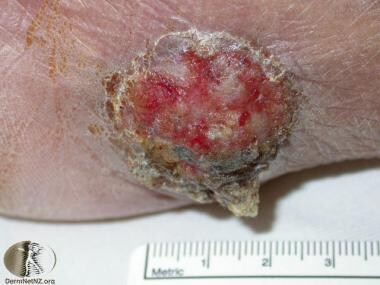Background
Carcinomas of the eccrine sweat gland represent a rare group of tumors with potential for local destruction and metastasis. High recurrence rates have been reported following conventional surgical excision of eccrine carcinomas. See the image below.
 Eccrine porocarcinoma. Courtesy of DermNet New Zealand (http://www.dermnetnz.org/topics/eccrine-porocarcinoma/).
Eccrine porocarcinoma. Courtesy of DermNet New Zealand (http://www.dermnetnz.org/topics/eccrine-porocarcinoma/).
The specific classification of eccrine carcinomas is both complex and nebulous, mostly because of the paucity of reported cases but also because many of these tumors show little histologic resemblance to mature eccrine glands. Histogenetic association is based primarily on histochemical, immunochemical, or ultrastructural features. Nevertheless, eccrine carcinomas may be taxonomically segregated into two main groups, as follows:
-
Those that are histologically similar to certain benign appendage tumors (eg, sclerosing sweat duct carcinoma, porocarcinoma, malignant chondroid syringoma, malignant nodular hidradenoma, malignant eccrine spiradenoma)
-
Those that show a diverse array of histologic features, not encapsulating any aspects of a benign counterpart
A slightly different method of eccrine carcinoma classification is suggested by Galadari et al, [1] who divide these tumors into those that arise de novo in normal skin and those that originate within preexisting benign sweat gland tumors. Precise identification based on histology is of significant importance because treatment and prognosis vary according to the microscopic appearance (see Histologic Findings).
Pathophysiology
There is damage to sweat glands and suppression of sweating, which disrupts thermoregulation.
Eccrine carcinoma may be derived de novo from any portion of the normal eccrine apparatus or result from the transformation of an existing benign eccrine tumor.
A 2000 study by Takata et al [2] examining the incidence of cytogenetic abnormalities in malignant eccrine tumors showed low incidences of loss of heterozygosity (LOH) or TP53 alterations in a mixed group of these neoplasms, in contrast to the frequent and multiple genetic abnormalities seen in tumors arising from epidermal keratinocytes. The authors hypothesize that this difference may be partly explained by the fact that the bulk of eccrine sweat glands lie deep in the dermis, an environment relatively protected from the sun and environmental mutagens. The precise role of ultraviolet radiation (UVR) on sweat glands remains to be elucidated. However, research shows UVR is known to suppress sweating, which disrupts body thermoregulation, and a study analyzing TP53 mutations in 16 sweat gland carcinomas identified 3 G:C → A:T transitions at dipyrimidine sequences on the antisense strand. [3]
Abbate et al [4] suggest that genetics may play a role in the development of microcystic adnexal carcinoma (MAC).
Etiology
Risk factors for eccrine carcinoma include family history, immunosuppression, and ultraviolet radiation (UVR). [5] A case of MAC was reported in the neck of a man who received radiation therapy to the site years earlier. In addition, Abbate et al [4] report that 5 of 10 patients with MAC gave a prior history of radiation therapy. Another report describes eccrine adenocarcinoma 20 years after radiotherapy. [6] Chiller et al [7] report a potential etiologic role for UVR as they describe MAC predominantly affecting the left side of the face, corresponding to higher UVR exposures while driving.
Immunosuppression has been known to increase the risk of nonmelanoma skin cancers, particularly squamous cell carcinomas. In a 2003 retrospective review of appendageal tumors in organ transplant recipients, Harwood et al [8] suggest that patients who are immunosuppressed have a propensity to also develop cutaneous appendageal tumors over their immunocompetent counterparts, with increased rates of both benign eccrine tumors and malignant eccrine tumors.
Epidemiology
Frequency
United States
Primary eccrine carcinomas are exceedingly rare, [9] accounting for roughly 1 of 13,000 specimens submitted to a dermatopathology laboratory. The more common subtypes include MAC, eccrine porocarcinoma, and hidradenocarcinoma. The less common subtypes include eccrine mucinous carcinoma, malignant eccrine spiradenoma, malignant mixed tumor, malignant cylindroma, and papillary eccrine adenoma.
International
Only several hundred cases of eccrine carcinoma have been reported in the literature worldwide. No specific data are available regarding United States versus international incidence of eccrine carcinoma.
Race
MAC was previously only described in white patients; however, Peterson et al [10] and Gardner et al [11] report the first and second cases of MAC affecting African Americans, respectively.
Sex
Sex incidence appears to be equal for eccrine carcinoma. Exceptions to this are the malignant chondroid syringoma and primary cutaneous adenoid cystic eccrine carcinoma, both of which occur more commonly in females than in males.
Age
Eccrine carcinomas most commonly are diagnosed in patients in their sixth through eighth decades of life.
Prognosis
Given the paucity of data on eccrine carcinomas, the prognosis remains unknown; the tumor appears to be locally aggressive but with a low probability of metastases (3.2%). [5, 12] Because eccrine ductal carcinoma is such a rare tumor, it has been included in the tumor, node, metastasis (TNM) staging for squamous cell carcinoma. [12]
-
Eccrine porocarcinoma. Courtesy of DermNet New Zealand (http://www.dermnetnz.org/topics/eccrine-porocarcinoma/).
-
Eccrine porocarcinoma. Courtesy of DermNet New Zealand (http://www.dermnetnz.org/topics/eccrine-porocarcinoma/).
-
Eccrine carcinoma pathology. Basaloid cells invading the dermis. Courtesy of DermNet New Zealand (http://www.dermnetnz.org/topics/eccrine-carcinoma-pathology/).
-
Eccrine carcinoma pathology. Tubule and gland formation infiltrating the sclerotic dermis; eccrine differentiation can be seen at high power. Courtesy of DermNet New Zealand (http://www.dermnetnz.org/topics/eccrine-carcinoma-pathology/).
-
Eccrine carcinoma pathology. Tubule and gland formation infiltrating the sclerotic dermis; eccrine differentiation can be seen at high power. Courtesy of DermNet New Zealand (http://www.dermnetnz.org/topics/eccrine-carcinoma-pathology/).
-
Eccrine carcinoma pathology. Tubule and gland formation, along with clear cell change. Courtesy of DermNet New Zealand (http://www.dermnetnz.org/topics/eccrine-carcinoma-pathology/).







